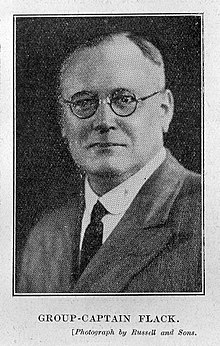Martin Flack
Martin William Flack (born March 20, 1882 in Borden , Kent , England , † August 16, 1931 in Halton ) was an English physiologist .
family
He was the son of the dealer and butcher in Borden.
education and profession
Flack's early years of study are closely linked to the acquaintance and influence of Arthur Keith , who set up a private laboratory in a farmhouse ( Mann's Place ) in Bredgar in 1903 . One day a dialogue ensued outside the house with Mr. Flack, the local merchant and butcher, who proudly reported that his son had just come from Oxford and intended to be a doctor. Eventually they met for tea. Keith gave Flack a scholarship to Wadham College in Oxford and recommended him after graduation (BA) for further medical training at the London Hospital, where Keith taught anatomy himself . This was the beginning of a lifelong friendship between the two scientists.
Flack deepened his studies at the University of Bern and in Liège . After returning to Oxford, he completed his scientific training (MB, B.Ch. 1908) and then worked as a demonstrator at the London Hospital Medical College (1905-1911). Until 1914 Flack held the lectures in physiology at the London Hospital Medical College and was a member of the research staff (applied physiology) of the Medical Research Committee (1914-1919). In 1919 Flack was appointed director of the Royal Air Force Medical Research Division.
power
In 1906 the investigations took place in Keith's small country house in Kent, which led to the first description of the sinus node ( Keith Flack node ). Keith had not experimentally proven the physiological pacemaker function of the node, but Flack showed in 1910 at Kronecker in Bern that the electrical, mechanical and cold stimulation of the node led to arrhythmias in the heart . In the original 1907 paper, Keith and Flack examined the muscular connections between the heart sections in all classes of vertebrates . It turned out that the dominant rhythmic impulse emanates from the muscle tissue of the sino-auricular connection: “As a result, we must assume that the impulse of the heart is passed on in the cardiac muscle tissue, that normally the impulse arises in the muscles of the sinus, the rhythm of the Determined by the heart and then running to the auricles and the ventricle, finally reaching the cord bulb. ” They demonstrated the morphological connection of the tissue structure found with the recently known AV node and the Tawara thighs within a postulated excitation conduction system with the sinus node as the highest Automation center.
In 1914, Flack and Leonard Hill began work on a physiological textbook. Flack preferred to deal with the physiology of the heart, the circulatory system and breathing , and also published numerous articles on aviation medicine .
In 1920, Flack presented a cardiovascular performance test (see also Valsalva test), a test of cardiac function for the pilot profession in England or for testing military fitness and fitness to fly (Flack test).
Works
- The form and nature of the muscular connections between the primary divisions of the vertebrate heart (with Arthur Keith). In: Journal of Anatomy and Physiology 41 (1907) 172
- A textbook of physiology by Martin William Flack, and Leonard Hill. Publisher Longman, Green New York, and Edward Arnold, London 1919
- Some considerations in the estimation of physical efficiency . Br Med J 2 (1923) 921
- The medical and surgical aspects of aviation; by H. Graeme Anderson. With chapters on applied physiology of aviation by Martin William Flack and The Aero-Neuroses of War-Pilots by Oliver Horsley Gotch
- The medical problems of flying including reports No. I-VII of the Air Medical Investigation Committee. Published by His Majesty's Stationary Office, London 1920
literature
- Eberhard J. Wormer : Syndromes of cardiology and their creators . Munich 1989, pp. 137-144
- Isidor Fischer : Biographical Lexicon of the Outstanding Doctors of the Last Fifty Years. Berlin 1932/33, vol. 1, p. 414
Web links
- Short biography whonamedit engl.
- History of the discovery of cardiac conduction engl. (PDF file; 598 kB)
| personal data | |
|---|---|
| SURNAME | Flack, Martin |
| ALTERNATIVE NAMES | Flack, Martin William (full name) |
| BRIEF DESCRIPTION | English physiologist |
| DATE OF BIRTH | March 20, 1882 |
| PLACE OF BIRTH | Borden , Kent , England |
| DATE OF DEATH | August 16, 1931 |
| Place of death | Halton |
